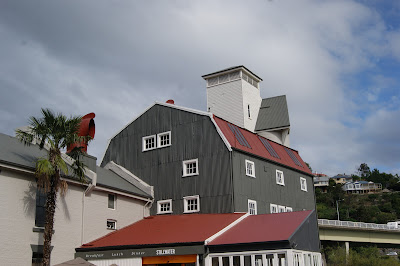Some residents objected, believing the Government should use the site to help supply water to Launceston. Walker was successful and in June 1831 Sibbald, the engineer in the partnership, began building a weir below the Basin. Governor Arthur proposed Walker supply water to Launceston from his mill race but the 1200 acres Walker requested in return was not agreed to and the deal failed.
The slow progress of work led to complaints from Launceston residents but Walker explained, ‘it is impossible to employ a great number of men as the rocks are almost perpendicular and very rugged.’ To combat the delays, Walker decided to build a temporary mill within the Cataract utilising the completed dam and race. It seemed a logical solution. With the small mill near completion and the 40 foot water wheel in place, the powerful Roderic O’Connor, Government Land Commissioner and Inspector of Roads revealed that the mill was on his property. There followed a public struggle and the press had a field day. Walker claimed that O’Connor had failed to improve his land therefore it should have reverted to the Crown. O’Connor claimed that he had planned a mill himself, but due to his commitment to Government duties, he had been unable to begin his project.
Finally the commissioners of the Caveat Board ruled that Walker had no claim, that O’Connor was the rightful owner, but it resolved that Walker could continue using the mill on the site for three years. Ironically O’Connor tried to sell his land eventually to Walker for a princely sum of £2000. Finally the family sold it to the Council in 1903 as part of Cataract Reserve.
Walker and Sibbald removed the mill in June 1835, but it was over twelve months before the fluming reached the new mill. Walker estimated losses of £1500 due to the fiasco. He sold his share to Mungo Somerville in 1837 who, with Sibbald, erected water tanks to provide Launceston’s first reliable water supply. At a cost of six pence to the carters, by the time it reached residents it ranged from eighteen pence to three shillings to out lying Windmill Hill, ‘and it frequently happened that half of it would be wasted by leakage from the purchaser’s casks and tubs which had become dry and shrunk.’
In 1845, three years after Somerville’s death, George Yates bought his share of the mill for £4400. The mill itself was considered a fine establishment with stores holding up to 10,000 bushels of wheat, a five bedroom brick cottage and other out buildings. Yet it was the income from the water supply, estimated to exceed £1500 per annum, that was ‘The El Dorado of Launceston’.
With Yates in financial difficulty, Walker bought back the half share, this time for £6000. He replaced the old wooden water wheel with a new iron wheel made in Hobart. Whilst the running of the mill changed hands over the next years, the major change was the development of the St Patrick’s River water scheme by the new Launceston Municipal Council. The mill became simply that, a flour mill.
Problems continued at the mill as employee Michael Connors, was ‘proceeding with bags of horse dung along the shoots to stop up some leaks…and when about half-way between the bridge and the bathing place, he stepped on one of the battens which was loose, and the unfortunate man was precipitated onto a rock about ten feet below, from which he bounded off to another rock lower down, then into the river.’
In 1876, David Ritchie purchased the Cataract Mill for £2800. The original wooden mill built by Sibbald was pulled down, ‘replaced with an iron mill and installed a complete set of Ganz rollers.’ He rebuilt the dam and the water wheel was replaced with a modern turbine. Unfortunately friction began over the new Duck Reach Power Station as Ritchie claimed water rights however it was damage sustained during the 1929 floods that led to the mill’s conversion to electricity.
The reinforced concrete silos, built in 1910, used cutting edge technology and were unique in Tasmania. Designed by Alexander North, ‘The silo consisted of five bins, and has a capacity of about 24,000 bushels of wheat. The wheat is conveyed from the receiving floor into the silo by a 4½ inch pipe, through which it runs by gravitation to the basement of the silo, whence it is raised to the top of the tower by an elevator, which lifts eight tons per hour with ease.’
A fire Christmas Eve 1943 destroyed a large portion of the mill. It was rebuilt the following year using the original oregon beams. Even with a £10,000 upgrade, it could not compete against the bigger Monds and Affleck who were ‘gradually absorbing the mill’s trade’. In 1974 the mill was bought by Monds and Affleck, the mill was ‘retired by its new owners’ and the silos were used for storage.
In the late 1970s, the mill was bought by the Tasmanian Government for an art gallery and craft centre. The restoration work was undertaken partially by the Government and by the Launceston City Council in line with National Trust guidelines to preserve the property’s heritage values.
In 2000 the Mill became home to the multi award-winning Stillwater Restaurant, River Café & Restaurant. A couple of years later The Mill Providore, Gifts & Gallery was established on the two floors above the restaurant. The site is considered historically important and the buildings demonstrate an early industrial function that is no longer practiced.
Main Text & Information Sources –













